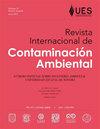厄瓜多尔基多每日食用三种蔬菜的膳食摄入量和镉和铅的营养转移
IF 0.4
4区 环境科学与生态学
Q4 ENVIRONMENTAL SCIENCES
引用次数: 0
摘要
日常食用的蔬菜中有毒金属的存在对人类健康是一个值得关注的问题。人们对厄瓜多尔基多市场上出售的蔬菜中有毒金属的浓度以及对人口的相应风险知之甚少。本研究以黑腹果蝇为研究对象,测定番茄、胡萝卜和生菜中镉、铅的浓度,评估其对人体健康的危害,并测定其营养转移因子。从基多4个当地市场采集蔬菜样品,采用微波辅助酸消化和原子吸收分光光度法测定蔬菜中Cd和Pb的浓度(以mg/kg干重表示)。用污染蔬菜喂养黑腹果蝇,测定其营养链中金属的去营养传递因子。结果表明,莴苣的Pb和Cd积累量最高。在所有情况下,铅和镉的浓度都超过了联合国粮农组织规定的最高水平。然而,每日金属摄入量和健康风险指数显示每日消费没有风险。Pb的营养转移因子在番茄食用蝇体内过高,表现为转移和积累。以番茄为食的蝇体内镉含量也最高。有毒金属从蔬菜到果蝇的营养链转移已被观察到,通过这些金属在果蝇体内的高积累,这表明对人类健康和生态系统都有负面影响。本文章由计算机程序翻译,如有差异,请以英文原文为准。
Dietary intake and trophic transfer of cadmium and lead from three daily consumption vegetables in Quito, Ecuador
The presence of toxic metals in vegetables of daily consumption is a concern for human health. Little is known about the concentration of toxic metals in vegetables sold in markets in Quito, Ecuador, and the corresponding risk to the population. This study aimed to measure the concentration of cadmium (Cd), and lead (Pb) in tomatoes, carrots, and lettuce, to estimate the risk for human health, and to determine the trophic transfer factor using Drosophila melanogaster flies. Vegetable samples were obtained from four local markets in Quito to measure the concentration of Cd and Pb (expressed in mg/kg of dry weight) in the vegetables by microwave-assisted acid digestion and atomic absorption spectrophotometry. Drosophila melanogaster flies were fed with contaminated vegetables to determine de trophic transfer factor of metals in the trophic chain. Our results showed the highest accumulation of Pb and Cd occurred in lettuce. In all cases, the Pb and Cd concentrations exceeded the maximum levels established by the Food and Agriculture Organization. However, the daily intake of metals and the health risk index showed no risk from daily consumption. Pb’s trophic transfer factor was excessively high in the tomato-fed flies, showing transference and accumulation in the flies. Cadmium concentration in tomato-fed flies was also the highest among the three vegetables. The trophic chain transfer of toxic metals from vegetables to Drosophila has been observed through a high accumulation of these metals in flies, and this suggests a negative impact on both human health and ecosystems.
求助全文
通过发布文献求助,成功后即可免费获取论文全文。
去求助
来源期刊

Revista Internacional De Contaminacion Ambiental
ENVIRONMENTAL SCIENCES-
CiteScore
0.90
自引率
16.70%
发文量
59
期刊介绍:
En esta revista se aceptan para su publicación trabajos originales y de revisión sobre aspectos físicos y químicos de la contaminación, investigaciones sobre la distribución y los efectos biológicos y ecológicos de los contaminantes; así como sobre tecnología e implementación de nuevas técnicas para su medida y control; también son aceptados estudios sociológicos, económicos y legales acerca del tema. Se publicarán los escritos que mediante arbitraje de especialistas y a juicio del Consejo Editorial tengan el nivel y la calidad adecuados para ello y su contenido será responsabilidad única de los autores. La Revista Internacional de Contaminación Ambiental es de periodicidad trimestral y se publica los días 1 de febrero, mayo, agosto y noviembre.
 求助内容:
求助内容: 应助结果提醒方式:
应助结果提醒方式:


